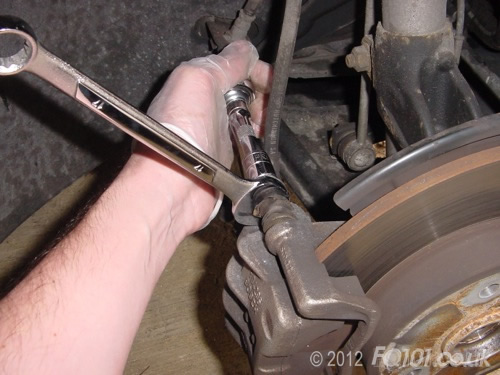The smart OEM brake pads are generally good for about 30,000 miles whereas the discs last longer. Standard smart pads can be bought for around £35 and are quite straightforward to fit as this guide aims to show.
To start, you need to slacken off the front wheel bolts, jack up the car and remove the wheel. We recommend supporting the front of the car on axle stands for extra safety.
With the wheel removed, you can access the top bolt of the caliper. Use a 17mm spanner as shown to hold the bolt piston while you slacken the bolt with a 13mm socket.
Once the bolt it removed, the caliper will swing down revealing the two brake pads. Lift both brake pads out of the frame taking care not to breathe in any brake dust.
The following picture compares a new pad with ones of those removed. Note how low the pad on the right has become. Any lower and there is a risk that the pad backing would have made made contact with the disc. Apart from making an awful noise, there is a risk that this would start damaging the disc.
Note: The pads with the metal tabs go at the back of the disk (in contact with the piston). Those without tabs go at the front.
Fit one of the new rear pads to the back of the disc as shown below.
As the old pads wore down over time, the brake piston extended to compenstate. As a result, you won't be able to fit the front pad until this piston has been moved back in.
To allow the brake piston to move, you need to release the pressure in the system. Open the front service hatch so that you have access to the brake fluid reservoir.
Unscrew the cap so that it is fully loose.
With the rear pad fitted, close the calliper and pull it towards you. You will need to push against the front of the caliper to stop the steering from turning as you do this. You will need to overcome a lot of resistance in the brake piston at first but it will then move. Keep an eye on your brake fluid reservoir as the level will rise. Be prepared to remove any excess from the reservoir before it overflows!
With the brake piston all the way back, you can now fit the front pad and close the caliper.
Check the the pad springs are correctly located as follows:
You will need to force the caliper shut in order to get the retaining bolt back in the top. Use the 17mm spanner to hold the bolt piston while you tighten the bolt up with the 13mm spanner.
Repeat for the other side.
Before completing the job, check the following:
- New pads are fitted correctly with their springs aligned as shown above.
- Caliper retaining bolts are fully tight
- Brake fluid is at the correct level in the reservoir
- Brake fluid reservoir cap has been tightened up.
Now refit the wheels and lower the car. Before driving anywhere, pump the brake pedal with the ignition on. Check that the brake pedal stiffens up correctly.

















